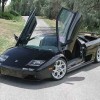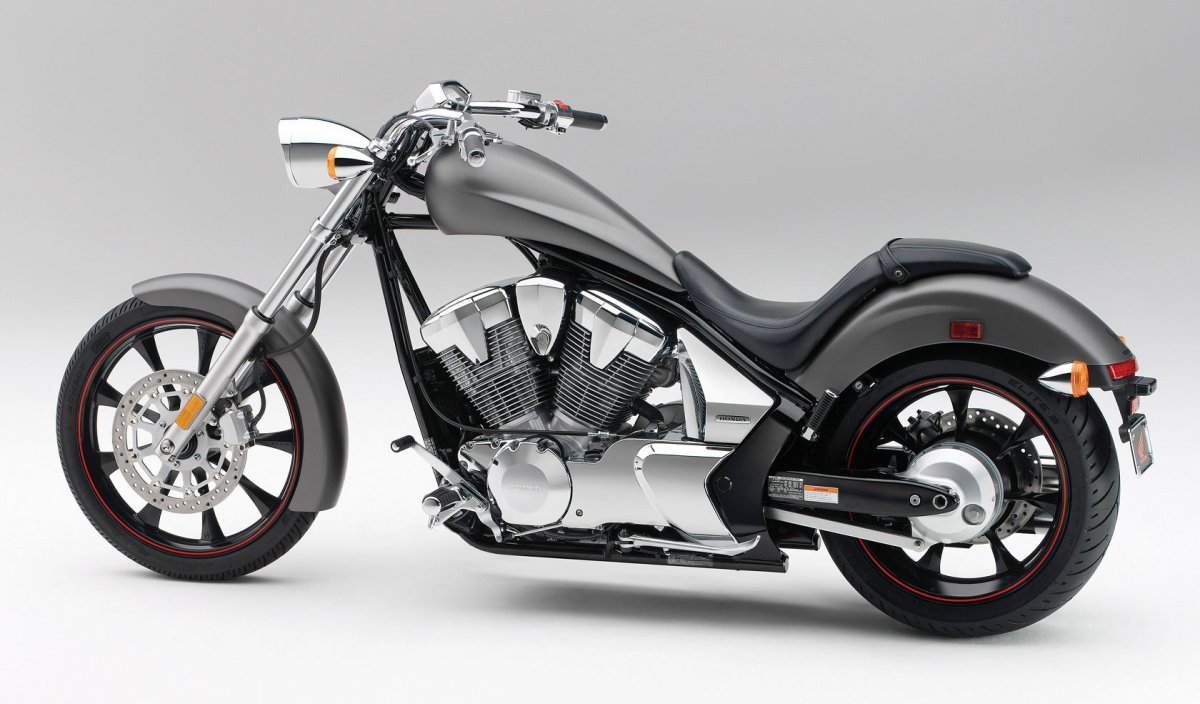Lamborghini Cars

Lamborghini Past & Present
Welcome to the greatest Lamborghini Car tribute lens. Here you will find out whatever you need to know about Lamborghini's cars both past and present.
Did you know that Lamborghini originally specialised in the manufacturing and construction of tractors.
Lamborghini Huracan
YouTube - Top Gear - Lamborghini
.

The Beginnning
The Lambo Tractor
Sig Ferruccio Lamborghini was from a farming background so when World War 2 was over he returned to Italy and began converting what the military left over in engines into powerful tractors. The high demand for these machines in the agri sector in Italy allowed Ferruccio's business to expand rapidly. In 1949 he built a completely new factory in Cento and founded Lamborghini Trattori SpA. With a daily production of one tractor this grew to 1500 a year by 1958.
The proud name of these machines was well lived, they won many tractor pulling contests and Ferruccio himself used to organise, the quality of these tractors was the best with all the parts being machined inside the factory at Cento.By 1969 the total output was 5000 units a year, this prompted a new move to a new factory with even bigger production space. Then there was a disaster when a large order was cancelled and Ferruccio lost confidence in the agri sector and sold the company to SAME Co. of Treviglio. they kept the factory open and by 1979 the former Lambo factory was producing 10000 units a year being exported all over the world.
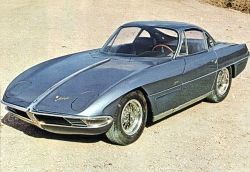
The Lamborghini Classics
THE 350 GTV
The first 'Gran Turismo' bearing the now famous bull emblem, was the 35O GTV from 1963. Before then, only farmers used tractors bearing this emblem. According to the legend, at this time, Ferruccio Lamborghini, who was already very wealthy, had some problems with his personal Ferrari, but the people who surrounded Enzo Ferrari at that time didn't pay any attention to this 'farmer'. Ferruccio was so angry, he decided to built his own car, and it would be more refined than any Ferrari. Ferruccio built a completely new factory just to create his ideal sportcars, but the 350 GTV was designed and built at the tractor factory at Cento, before the Sant'Agatha factory was completed. The engine became a V-12 of course, designed by Giotto Bizzarrini, who recently had left Ferrari. This beautiful engine first roared into life on Lamborghini's Schenk Dynometer on May 15, 1963 (according to Rob de la Rive Box). The power output on these first tests was 350 DIN (374 SAE) horsepower at 8000 rpm. However, Ferruccio didn't want a highly tuned racing engine, but a smooth running touring car, so Bizzarrini lowered the output to 'only' 270 bhp at 6500 rpm for the 350 GT production car. The square steel tube chassis used for this prototype was welded up by Neri & Bonacini of Modena, who actually made two slightly different chassis, the engine used many parts manufactured by ATS Microfusioni at Sasso Marconi and the gearbox was bought from ZF, completed by a differential from Salisburry.
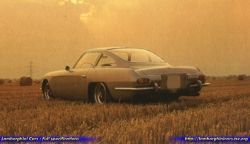
THE 350 GT
THE NEXT STEP
Carrozzeria Touring of Bianchi Anderloni redesigned the 350 GTV,the exterior was changed, even the chassis was altered.Touring also built the 35O GT, and used it's patented SuperLeggera method for it. The pop-up headlights of the 350 GTV were replaced by fixed oval.
The complete body design was smoothened but the overall looks were still different from any other car, but at least now they were very pleasing. On the engine, the rather expensive and rare vertical Weber carburetors were removed, and horizontal, side-draught ones were installed.
All these changes created the 35O GT (the 'V' for Veloce was dropped) in just five months, and everybody looked with great astonishment at the car on the 1964 Geneva Auto Show, orders for it began coming in. Once the car was released for road testing, people liked it even more, this was a smooth-running, sophisticated high-performer that was generally faster and technically ahead of everything Ferrari had been offering.
In 1966, Lamborghini made little refinements to it, the front grill styling was altered, now with two horizontal bars in the air-intake. A second windscreen wiper was added and a rear backup light was installed underneath the license plate holder. Two air intakes appeared ahead of the windscreen, and in the interior, the dashboard trim was changed to leather, instead of the early polished aluminium.
That same year, Lamborghini could install a 4.0-Liter engine into the 350 GT chassis, resulting in the 400 GT.
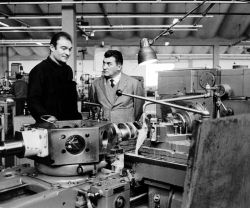
The black leather interior of this protype was produced by an external upholsterer and the body of the 350 GTV was designed by Franco Scaglione, and was built by Sargiotto Bodyworks of Turin, so other than careful assembling of the different components, not much was really build by Automobili Lamborghini SpA, not yet anyway.
This prototype was finished in a bright metallic blue and attracted a lot of attention on the 1963 Turin Auto Show. The fabulous engine was put next to the car and in the engine compartment they put a cradle of ceramic tiles ! The engine couldn't be installed in the car because with its vertical carburetors, it didn't fit under the hood. Recently the car has been restored for collector Romano Bernardoni, by Emilianauto of Bologna. After 20 years in storage, this time the engine was built into the car which caused major modifications to the chassis. It is now finished in a bright metallic green with a light-toned leather interior, and the car is fully driveable. The 350 GTV was intended to be placed in the official Lamborghini museum, together with other memorable Lamborghini's, but this priceless piece of Automobili Lamborghini SpA history was sold to a collector in Japan, where the car resided in the Noritake Collection for several years.
Today this unique car is shown in the official Lamborghini museum located at the factory, joined by the very last Countach ever built next to one of the first Countach ever made, and some of the other special Lamborghini's that were built during the years, like the Diablo Roadster prototype and the Cala.
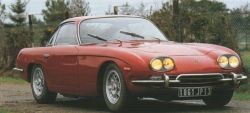
THE 400 GT
A REAL GT PERFORMANCE CAR
Lamborghini V-12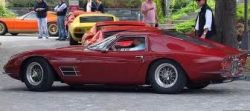
Lamborghini 400 GT 2+2
A 4 SEATER WITH A LOT OF PUNCH
Most people only know the dramatic, ultra-high performance cars from Sant'Agatha, like the Miura or Countach, they only offer - sometimes even barely enough - space for two. But Ferruccio Lamborghini didn't start by building these legends, he actually wanted to build cars like the 400 GT 2+2, a smooth-running, easy to drive Gran Turismo.
The 400 GT 2+2 qualified both of these criteria, and also offered comfort and a frightning top speed, it was first shown to the public on March 1966 at the Geneva Auto Show.
The 350 GT and the 400 GT 2+2 look very much alike, but closer examination reveals quite a lot of differences, actually almost no body panel can be interchanged between them, partly because the 400 GT 2+2 had an all-steel body.
The 4OO GT 2+2 is also some 65 mm taller than the 350 GT, it might not look as exciting as a 350 GT, but the 400 GT 2+2 was produced in greater numbers, it is however still considered a rare sight. The first difference you notice are the quad headlights, who replaced the awkward looking oval units. Lamborghini built its own transmission and differential, this way Ferruccio could asure himself of almost all the pieces he needed to build 'his' cars under the one roof.
The 400 GT 2+2 was a good seller, totalling at 224 units it outsold the 350 by more than 100 units, however the two extra seats costed about $ 500 each, a rather stiff fare in 1966. If you look for an early Lamborghini, try the 400 GT 2+2, it will be easier to find, and, thanks to the steel body, cheaper and easier to restore, some bodyparts are actually still available.
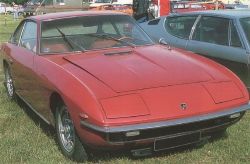
Lamborghini Islero
SAME SAME BUT DIFFERENT
The Islero 400 GT was presented on the 1968 Geneva Auto Show, alongside the brand new Espada, the 400 GT's looks had completely changed, now with hidden headlamps and square-cut contours.
For the restyling of the Islero, Ferruccio Lamborghini contracted Mario Marazzi, a former employee who had started his own coachbuilding company, he also got to build the Islero bodywork.
The Islero was a clean and inoffensive car to look at, but lacked the personality of the 400 GT 2+2, and it paled next to the sensational Miura and the big Espada.
Inside, air-conditioning was standard now, together with more head- and legroom, it also featured a new dashboard design.
The Islero, like its successor the Jarama, are rather less well known Lamborghini's, and only 125 were built, which is a pity, because the Islero had a towering top speed and driving it was very easy, but it only lasted one year, an improved 'S' model took over in 1969, but was also dropped after only one year, to be succeeded by the Jarama.
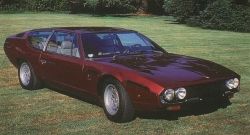
The Espada 400 GTE
The Espada Grand Turismo In Style
The Espada was introduced on the 1972 Turin Auto Show. In the interior, the dashboard was wrapped toward the driver and wood was used instead of aluminium (Which had been the case is some of lamborghini's earlier cars), power-steering was made standard, along with air-conditioning, the center console now had a more upright kickup from the front. Underneath the bodywork, the rear triangular suspension arms were modified, the spring and shock rates rejigged, and the disc brakes were again upgraded, and under the hood, two alternators were installed. Available options now include a sunroof which wasn't demanded much, and also from 1974 on, a Chrysler automatic transmission could be ordered. Starting in 1976, the same black 'safety bumpers' needed for the U.S. market were installed on the cars for the European market, and by some specialists, these late Espada's were called the Series IV, but the factory kept calling it the Series III. Although this last model of the Espada was kept in production for the longest period in its six years production, it only sold 456 units. The complete Espada production totalled at 1217 units, making it Lamborghini's second biggest success, only the Countach would top this figure much later. Even today, the styling of the Espada is as fresh as 20 years ago, it is still a head-turner, people still stare at it every time one passes by.
Towards the end of the production life for the Espada, Bertone had designed a four-door version of this high-speed luxury cruiser, the overall looks of this final design were very good, but for some reason Lamborghini didn't take this new Espada into production, which could be seen as a pity, because it would surely sell quite good.
But I suppose after being in production for so long, the Espada was ready to be retired and replaced by a completely new model ???
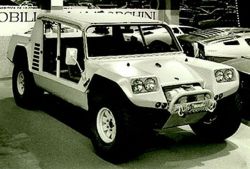
The Lamborghini Jeep the First Attempt
If at first you fail try again!
The first Lamborghini off-road, that wasn't a tractor, was the Cheetah, it was built on contract for the American firm Mobility Technology International, which were contacted by the U.S. military to design and built an all-terrain vehicle.
M.T.I. would sell the car while it would be built in Sant'Agata, Lamborghini didn't have the time to completely design the Cheetah itself, so basic instructions were taken from M.T.I., who unfortunately just copied a very well known vehicle, the FMC XR 311.
This resulted in threads of legal action by FMC against M.T.I. and Lamborghini when the final prototype was presented to the people on the 1977 Geneva Auto Show.
The Cheetah was designed and built in San José, California, after completing the prototype, MTI sent it to Sant'Agata were the Lamborghini engineers and technicians carried out a few modifications and brought it up to the production standards.
However, this was only the first of a series of mistakes made with the Cheetah, Lamborghini decided to use a big 5.9-Litre Chrysler engine, coupled to a 3-speed automatic gearbox, driving the four wheels. The engine was mounted in the rear which caused the weight balance to be completely wrong, resulting in very poor road-manners. The Cheetah was designed to carry four armed people and a driver, a Fiberglass body was used, but the Cheetah was far too heavy for the underpowered engine, so overall performance was very poor. This engine was waterproofed and the radiator was protected by an infrared detection system.
The decision to use an American made engine was probably made to gain the U.S.-Army contract, but it was very soon obvious the U.S. wouldn't invest in anything built outside the United States, and the Cheetah was rejected almost at once, it was however tested in dessert runs, and was subsequently crashed during one of those test.
The Cheetah was completely destroyed, but the wreck was never returned to Italy, it's whereabouts today are unknown.
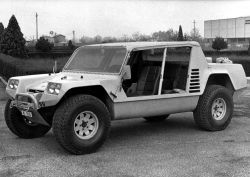
The construction of the Cheetah took a lot of money, which should have been used to design and built BMW E-26 prototype, which would become the successful M-1, but the money ran out and the production of the BMW couldn't be started on the agreed date, resulting in the loss of the contract with the Americans.
The Cheetah was offered at $25.000 at that time, and an brochure was even made in Arab to attract the attention of the wealthy sheikhs, but neither the Army or any Arms manufacturer was interested, and after the crash of the prototype, Lamborghini didn't built a second Cheetah, but was left in even worse financial problems than before, things were looking very bad for Lamborghini in 1977, but they would be back, even with a successful four-wheel drive all-terrain Lamborghini.
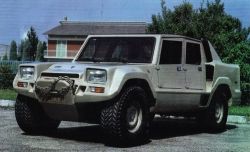
The Lamborghini LM001/LM002
Another attempt at the 4X4
After the Cheetah mishap, the idea of an off-road Lamborghini was still alive, and the new money that came with the entry of the Mimram brothers (which had unlimited funds according to their Swiss banks) made it possible to redesign the Cheetah into the LM-001.
The LM-001 took the Cheetah design one step further, the engine was kept in the back, but it was decided to use the Lamborghini V-12 unit, now with a 4754 cc piston displacement to increase the flexibility and handling of this heavy machine. However, the first LM-001 used a 5896 cc AMC V-8 engine, but the choice of the engine wasn't the problem, the location of it was the major problem.
The LM-001 was presented on the 1981 Geneva Auto Show, together with the new Jalpa, the body design used a lot of flat panels to make it easier to install armour-plated ones. It was still a four-seater, but now with four doors and two rectangular head lamps (some photo's show the Cheeath with doors installed, but it was mostly shown without doors or roof). Just behind the rear doors were big air intakes to cool the engine, but because it was placed in the back, the road holding capabilities weren't very good, while accelerating, the front became too light for best steering control, but this would be solved with a third car, which used the famous Lamborghini V-12 in the front, the LMA-002.
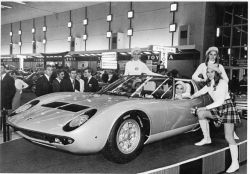
The Lamborghini - Miura
First of Ferruccio's supercars
After only three years of production, during which Ferruccio built the very nice 350 GT and later the 400 GT, he stunned the world by showing an innovative rolling chassis at the1965 Turin Auto Show.
This chassis showed a transversely mid-mounted, compact V12 engine, something the world had only seen in purebred race cars before, but never on a road going exotic.
With this new design, Lamborghini was years ahead of the competition, which laughed at him, they stated he would never be able to put this into production ... they couldn't have been more wrong.
It still took the small firm several months, but with the help of Bertone and the genius of Marcello Gandini, who's name was linked to the amazing design of this new Lamborghini, Ferruccio was able to show a finished show car by the 1966 Geneva Auto Salon in March.
Granted, this was still a prototype, using 0.8mm sheet steel and bearing chassis number 0509 with a wheelbase of 2460mm ... note that the prototype chassis was rolling on genuine Borrani wire wheels, but now the Miura was riding on specifically designed Campagnolo wheels.
Still the overall design was set for the production model, however the chassis would be made from 0.9mm steel and the wheelbase a bit longer at 2500mm to improve interior space for the driver and passenger.
Livid customers and designers from the competition nearly fell over each other to get a glimpse of this brand new super exotic car. Ferruccio Lamborghini intended to build only a handful of these, all on special order, but soon demand grew beyond his wildest dreams.
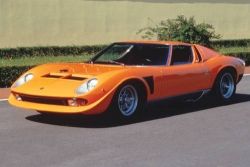
Automobili Lamborghini still had a lot of work to do on the Miura, a name taken from the ferocious Spanish fighting bulls which would be a suitable name for their latest P400 creation.
The initial 'Geneva' prototype used a glass engine cover, but that soon proved totally useless to draw hot air out of the engine bay. They even made additional holes in the glass and an extra air intake into the roof to draw fresh air into the cockpit.
At that time using louvres on a super car was yet unseen, because of their angle they both allowed decent rearward vision for the driver and pulled hot air out of the engine bay, hence keeping the engine cool ... note that this kind of louvres would be installed on lots of cars later on as a 'tuning' item.
In total Lamborghini built three pre-production prototypes, chassis numbers 0706, 0862 and 0961 before the first Miura was delivered on December 29th 1966 to Lambocar, the Milan dealership. Continuing customer deliveries started in 1967 with actual production Miura having a 10mm higher roof and seats lowered into the chassis by 10mm to further improve creature comfort inside this amazing exotic car.
Chassis number 3312 marked another major modification in the Miura production, this was the 125th P400 made and now used a full 1 mm steel for the chassis ... customers complained about chassis flexing under hard cornering, so they made the sheet steel used thicker to stiffen up the underpinnings of the Miura, many owners would have their Miura modified on the end to counteract any flexing on early chassis.
Note however that vision from the interior rear view mirror was restricted by a quad setup of triple Weber carburetors, a magnificent sight in itself, anyway, those driving behind you would never be able to keep up anyway. The official top speed of the original Lamborghini Miura was set at 280 Km/h (174 Mph) and acceleration figures of 6.7 seconds to reach 100 Km/h while the 100 Mph was obtained in only 14.3 seconds.
All this from a very compact V12 engine that delivered no less than 350 Bhp at 7000 rpm and sat inches behind your ears when seated behind the steering wheel, with a special Visarm glass to keep noise bearable, which didn't work in the end, the cockpit could become very hot ... and a climate control system wouldn't be available until years later.
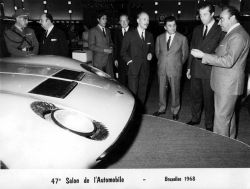
With a very sensual styling the Miura became an instant hit, but it had some items that required constant attention from the lucky owner ... riding at only 1055 high with a ground clearance of a mere 130mm the sidewalk suddenly becomes a very expensive problem, also those magnesium wheels look stunning, but don't dent them ... another very expensive mistake these days.
A Lamborghini Miura looked fast, and with that much power on hand it was fast ... but it could suffer from a severe front lift towards the 280 Km/h top speed, so many owners reverted to installing chin spoilers or small fins on the front corners to keep the nose down at high speeds.
Still the Lamborghini Miura P400 was a masterpiece in automotive history, people still regard this car as one of the most innovative models ever to be built in Italy, let alone in Sant'Agata by a company that was founded a few years earlier ... the Miura P400 model was built in 475 units before an even wilder version, the P400 S was introduced.
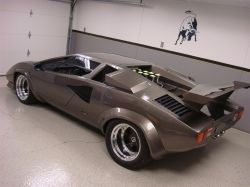
The Lamborghini - Countach
On the1971 Geneva Auto Show Lamborghini introduced the mind-blowing Countach, the full denomination was LP 500 Countach, where the LP stood for Longitudinale Posteriore 5000 cc, and the 5-Liter engine was put longitudinally in the back.
This new 5-Liter engine, which was built using a lot of magnesium even for the gearbox and differential, was completely designed and built by Lamborghini, while Bertone, more precisely by Marcello Gandini, executed the body design.
At Lamborghini,Paolo Stanzani was responsible for the engineering, the transmission which was put directly underneath the gear lever, so no complicated linkage was necessary for it, the gearbox was linked with the rear mounted differential through a long shaft in the bottom of the engine, gearbox and differential were mainly built from magnesium to reduce their weight.
The body styling was executed by Marcello Gandini, its upward and forward swinging doors were inspired on the Carabo, which was based on an Alfa Romeo chassis, these doors together with a periscope rear view mirror mounted in a tunnel in the roof were only a few of the main attractions on the Countach. The Countach looked awesome, a futuristic prototype, a one-off, but the critics were wrong, the Countach was destined to go into production, and shortly after the introduction, Ferruccio Lamborghini halted the Miura SV production, to be succeeded by the Countach. 'Countach' is in fact a Piedmontese dialect, and means something like stupendous, magnificent, splendid. There are several legends surrounding the origin of this name, but the official factory version is that it was Bertone's first word when he saw the result of Gandini's pen. Ferruccio Lamborghini himself was present at the time and decided that this name would fit the new Lamborghini perfectly.
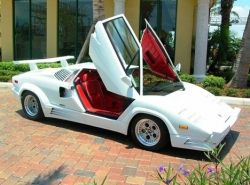
This first Countach was a real show car, the dashboard did not have the normal analog instrumentation, but Bertone used experimental digital units, while a first edition of the check computer was installed, monitoring all the important areas of the car like the different fluids, the brakes, etc... Later when testing the LP500, he had the digital instrumentation replaced with normal ones. From the first moment on, the orders started coming in, at that time it was not even sure the car would actually be produced, but after Ferruccio saw how much people were willing to buy a Countach he decided to build it in small quantities. This first prototype, which was finished in a bright yellow, had only a short life, which was very hard. Various modifications were needed to transform the unique prototype into a production model, large air scoops were installed on top of the rear fenders to pull the air into the radiators, who were now mounted vertically.
In addition, a pair of NACA-ducts were cut behind the doors and various windshield wipers were tested, after several thousands of hard miles the car ended its life with a barrier crash test at MIRA in Britain.
After this first rolling prototype, two others were built to get the Countach into production, a red one that was still close to the original design but now with the big air intakes already built into the car from the start. On this red car, a test was performed with dual windscreen wipers, residing both to the left and right of the front windscreen, but this system proved to be inadequate under rain at high speeds.
This second prototype was also heavily tested using several circuit runs, but a third prototype was needed to be really able to get the Countach ready, this green example was later also used for the first official factory brochure offering the Lamborghini Countach LP400 as a production model, later another brochure was created with an actual yellow production car. This green car already featured the single windscreen wiper system that would be used on the actual LP400, the front bumper now was lowered a bit, and included driving lights like the LP400 would later on.
Both these late prototypes used the 4-Liter engine, which would be built into the actual production model, but the side window configuration of these prototypes never made it into production.
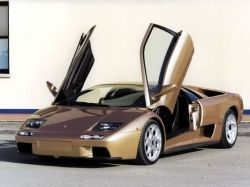
The Lamborghini - Diablo
The Devil is created!!!
In June 1985, Automobili Lamborghini decided it was time to start thinking about a replacement for their legendary Countach; it would take the Lamborghini development team another five years to complete the new super car, the Diablo.
The Diablo was presented to the public on January 21. 1990, at the Hotel de Paris in Monte Carlo during the second Lamborghini Day (the first one was held when the Anniversario was presented in 1988), after five years of development and about 6,000,000,000 Lire went into the project.
The name 'Diablo' was in fact taken from a ferocious bull raised by the Duke of Veragua in the 19th century, it fought an epic battle with 'El Chicorro' in Madrid on July 11. 1869, this animal became legendary and it's well-known history and it's name were aggressive enough to be used for a Lamborghini.
The main directive for the Diablo was simple; its top speed had to be at least 315 Km/h., so work began on the successor of the Countach. For the design of the bodywork Lamborghini contacted Marcello Gandini, he also designed the Miura and Countach, so he was the obvious person to design the new Lamborghini, but his initial design was altered, first under his own directions, later by the Chrysler Styling Center in Detroit.
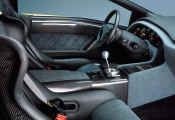
Chrysler owned Automobili Lamborghini from 1987 on, and arrived right in the middle of the development of project 132(the Diablo).
They changed the design to something more human, more practical, but also less violent, less aggressive. Nevertheless, the overall lines still looked close enough to have Marcello Gandini put his autograph on the side of the car.
The Diablo was still a true Lamborghini, low, wide and extremely fast, its top speed was set at 325 Km/h., but on the Nardo test track, the test driver managed to reach 340 Km/h. To reach these speeds, the Diablo received a modified V-12 engine, still with four valves per cylinder, but now with a displacement of 5.7 liters and a newly developed multi-point fuel injection system. Lamborghini has developed this electronic system with the assistance of Weber and Marelli. The engine now pumps out a healthy 492 Bhp, again placing this new Lamborghini at the top of the super car market (if you do not count the limited edition Bugatti and Jaguar XJ-220).
The body design no longer suffered from the big air intakes on the rear 'shoulders' as on the Countach, now these intakes were neatly incorporated into the lines, and supplied air to the radiators, which were placed at the far rear of the car.
A rear bumper with integrated spoiler kept the engine compartment cool by pulling out the hot air, while a big rear wing could still be ordered as a $4,500 option. An air intake on each side in front of the rear wheels cooled the big rear disk brakes, while in the front spoiler, next to the flashing lights, an extra intake was mounted to cool the front brakes.
These brakes were covered with massive 17-inch wheels with big Pirelli P Zero's mounted on them. The wheels were a new design that looked something like the wheels on the first Countach LP400 S, but were now multi-piece aluminum alloy OZ.
On the new Diablo, much use was made of composites, a high-strength alloy was used for the passenger 'cell', while the front and rear used a lesser alloy, the body of the Diablo still used aluminum alloy in most parts, but the front and rear sections were made of composites, as was the engine cover and front lid. However, all exterior panels offered an improved quality of their surface to allow an excellent finish.
There were no more wheel arch extensions on the Diablo, however, it was just as wide as the Countach, at 204 cm width, parking would still be difficult, but the doors opened in the familiar Countach way, up and forward. These doors now had side windows in one piece, which went all the way down, and were electrically powered.
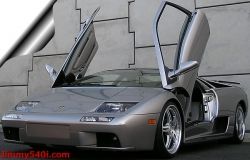
Side visibility was therefore much better than on the Countach; also because at the front of the doors, the window-line dipped down to allow a better view in the exterior mirrors. On the Diablo, you could even see something through the interior rear view mirror, because the engine lid was not blocking the view, on this first version of the Diablo that is.
The interior was also completely redesigned, this time by the Chrysler Design Center in Detroit. The seats were again fully adjustable, and could even be ordered on size for the customer. The dashboard was a big block in front of you, but it did not seem to block the view, it could be adjusted in height together with the steering wheel, which could also be adjusted in reach.
Inside you would find the best hand-stitched Italian leather, but also a high power Alpine stereo system, with either a cassette player or a compact disk player. An optional remote CD changer was available, together with a sub woofer system. The entry into the interior was much easier than on the Countach, the door opened wider and you could just sit on the sill and 'drop' into the seat without hitting the roof or the door.
Factory options included the rear wing, but also a factory fitted luggage set ($2,600) could be ordered, and for the inside, an exclusive Breguet clock could be fitted (at $10,500).
Owners started taking delivery of this ultimate Lamborghini in June 1990, exactly five years after the start of the project, and the Diablo sold well, it showed up in various test reports all over the world, always with great success. A few faults were however still there, the heavy steering and the same heavy operation of the clutch; two problems that always were present on Lamborghini's.
But the new Diablo VT would have power steering, and the clutch was modified so the Diablo became easier to handle. When the Diablo VT was presented to the public, the smaller dashboard and the front air intakes underneath the fog/driving lights were also used on the Diablo 2WD.
During the 1998 production year, the driver airbag became available and the dashboard was again slightly redesigned to obtain a very clean look on the inside of the Diablo super car.
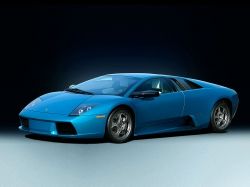
The Lamborghini - Murcielago
"born from below the earth, like a volcanic eruption, under thundering lightning it will emerge from the dark ..."
When Audi took over Lamborghini it s design concepts did also, the previous design model the Zagato Canto was not liked by the Lamborghini President (the replacement for the Diablo).He asked for a new proposition from the Audi design department, this one would be compared with a reworked Zagato Canto, a prototype design from the Bertone Design Studio's. Zagato's new design was again rejected, also the model wasn't what the President had in mind, so the Bertone Design and the one from Audi would be used together. At this moment, time was running out on the Diablo replacement, so a restyling of the current model was needed, before the focus could be directed to the new model.
The Audi designer Luc Donckerwolcke was asked to update the aging style of the Diablo, so he created the refreshing 6.0 VT model, when we look at it, now that the L147 is shown, it is clear this model was a preview of what Lamborghini was about to present as a successor.
'A Lamborghini isn't just designed and presented to the public like a normal car, it is born from below the earth, like a volcanic eruption, under thundering lightning it will emerge from the dark ....' - Luc Donckerwolcke.
Automobili Lamborghini SpA actually invited owners and enthusiasts from all over the world to witness the unveiling of their new model (the Murcielago) during a special event on September 8th 2001 at the factory, on Sunday morning the car would be shown on the town square of Bologna to the public together with a large selection of stunning Lamborghini's that were present, over 180 different cars were at the factory that weekend, most of them joined the Murciélago in Bologna.
It was possible to take a look on the factory floor and visit the brand new official museum and restoration department before a special show was organized to unveil the brand new, long awaited Lamborghini. The Murciélago was unveiled at 7 pm on the Saturday evening, when it was driven onto a stage in a secured section of the factory floor, a shining, 'Miura' green metallic Lamborghini was presented, while two other cars, a black one and a yellow one, were simultaneously unveiled in the large entry hall of the factory.
As usual with Lamborghini, the 'Murciélago' name was taken from bullfighting, during a fight in 1879, this legendary bull was still standing after 24 stabs from the 'espada', the matador's sword. Pressured by the audience, this fierce bull was kept alive, later it was acquired by Don Antonio Miura, yes, the guy that bred the famous Miura bulls that named the very first mid-engine road car, the magnificent Lamborghini Miura.
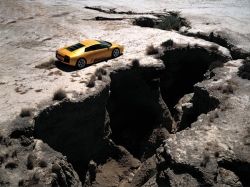
The rather controversial styling of this new Lamborghini stirred some emotions from both owners and enthusiasts all over the world, it is true that the refreshing new Murciélago design wasn't created by an Italian, but by Luc Donckerwolcke, who was also present at the presentation at the factory. At first Luc Donckerwolke supervised the design together with a team of Bertone designers, but this combination didn't work out so it was decided to end this partnership and the new Lamborghini would be designed by Luc Donckerwolcke himself.
This 36 years old, Belgian designer, was raised in Peru, where his father was working as a diplomat, he first got an engineering degree before he successfully followed a degree in design.
He ended up at Peugeot and a year later, during 1992 he joined Audi AG, where he designed the stunning A4 Avant, after that he was responsible for the new designs at Skoda, where the Fabia and Octavia were drawn by him.
He returned to Audi to design the aluminum A2 model and the R8 Le Mans race car, he can also be held responsible for the prototype shown by Audi during the 1998 Paris Auto Show, it was in fact during that show that his bosses, among them Peter Schreyer, called him into an office and proposed him to design a car in a foreign country, Luc actually had to decide what to do without knowing Mr Schreyer was talking about Lamborghini, when Donckerwolcke accepted he sure didn't regret this decision.
Donckerwolcke wanted to create the ultimate Lamborghini, a combination of the best Automobili Lamborghini SpA offered until now, the Murciélago boasts a rather angular design, one could say it looks like a direct successor to the Countach, using similar angular lines at the front, although completely up to date. Some Diablo influence was also visible in the rather forward driving position, while the engine cover reminds us of the legendary Miura, it is therefore save to say, that even if it wasn't designed in Italy, the design still uses some details from the most famous Lamborghini models in the past to take the new Lamborghini model ahead into the future.
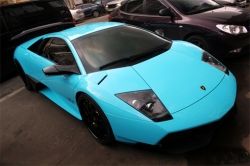
The styling of the Murciélago could be seen as an evolution of the last Diablo model, but it is clearly visible this new car featured a very clean design with a highly professional look, also the Murciélago still uses the wedge shape body style with the cockpit completely integrated into the overall body. The design featured very angular lines, especially at the front, combined with magnificent curves and covered with various air intakes and outlets to cool the massive brakes and fabulous V12 engine. Lamborghini even revived the stunning 'Miura green' color on this new model. Note that there is no signature of the designer found on the car, not like on the early Diablo, were Marcello Gandini's signature was mounted on the side.
The engine in the Murciélago was still closely related to the famous V12 that roared into life over 30 years ago, but now used the latest technology in motor management. Also a dry sump lubrication was used on this 6.2 liter unit, which allowed the engine to be lowered a full 50 mm in the chassis, improving the weight ratio and road holding capabilities of the new Lamborghini.
At first the Murciélago would use the 6.0 liter engine used in the Diablo 6.0 VT, but Lamborghini's Engineering Director, Massimo Ceccarani didn't think the possible customers would like the fact that the latest Lamborghini used an engine with the same displacement as the 'older' model. Therefore they decided to create a 6.2 liter unit, three prototype engines were tested on the Lamborghini test benches and proved to be extremely reliable, note that this new engine had an enlarged stroke of 86.8 mm resulting in a displacement of exactly 6192cc.
Torque output was very important in the development of this new engine, a very flat curve and a value of 650 Nm at 5400 rpm with a power output of nearly 600 Bhp was the result, however the placement of the radiators to cool this 'hot-blooded' power plant at the rear of the car caused some headaches to Luc Donckerwolcke.
Enough cool air was needed to flow through the engine compartment, but the amount of air needed varied depending on the outside conditions and the cars actual speed, so installing intakes that would supply enough air, even at the most extreme conditions would be overkill, several options were tried and Luc finally decided on a system that was used in the Countach Restyling prototype, adjustable intakes, these were designed to be neatly integrated into the overall Murciélago design.
Most of the time the intakes will only be raised when the car is at rest or driving slowly because at speed the intakes are sufficient in their lowered position, the positioning is naturally fully automatic, although a dashboard mounted button can also raise them, just to impress the guy next to you.The intakes would automatically open when the engine temperature rose above normal operating levels or when the outside temperature was above 32C, also once the speed of the car reaches 125mph, they would be retracted again to improve the aerodynamics of this Lamborghini.
The Lamborghini Murciélago will currently only be available in the well known VT version, a right hand drive version will become available during 2002 with a Roadster version following in 2004, when the new L140 V10 powered model will also be introduced for which both Luc Donckerwolcke and Giorgetto Giugiaro have made designs.
This new model, which could very well use the 'Gallardo' name, will be built on an aluminum space frame with an alloy body. Just like with the Jalpa in it's time, this new Gallardo bodywork will be built at an Audi plant in Neckersulm, from where the finished body shells will be shipped to Sant'Agata for finishing.
One can say without a doubt that the new Lamborghini model was probably the most developed model ever built by Automobili Lamborghini SpA, with the help of Audi this Lamborghini was thoroughly tested and re-tested, until everything was exactly to way it should be. The Murciélago had been tested in the most extreme environmental conditions, this was actually a first for Lamborghini, since the previous models were all tested on the roads surrounding Sant'Agata and on the Nardo circuit. The Murciélago was even taken to a deserted area in the United States to be tested in very high temperatures and at a very low humidity, just to make sure it would perform up to the specifications, no matter under which conditions.
Another note is that there were only 5 Diablo prototypes built before production began, while a total of twelve Murciélago road going test cars were made, with different bodies naturally, another four units were built to perform crash tests and airbag tests, the Murciélago was tested on the Nürnburgring and various test circuits from VW and Audi while top speed tests were conducted on the Nardo and the Imola circuits.
This new Lamborghini drove like no other model ever before.
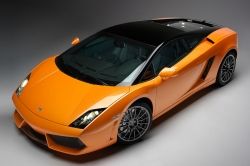
The Lamborghini - Gallardo
The most successful Lambo!
Finally the new 'entry level' Lamborghini was presented to the public, the long awaited Lamborghini Gallardo was introduced during the 2003 edition of the Geneva Auto Show, drawing a lot of attention and reactions ... both good and bad.
The styling of this new Lamborghini model was very refreshing, somewhat angular and odd shaped in some places, but very different from anything Automobili Lamborghini SpA ever offered in the past, Fabrizio Giugiaro (ItalDesign/Giugiaro) sketched the original design down but Luc Donckerwolcke at the new Lamborghini Centro Stile did the final touches.
By using a rather long wheelbase and short overhang to both the front and rear, the initial impression of the Gallardo was rather muscular and dynamic, while retaining a 'compact' look.
The 'forward leaning' side view mirrors tend to create an impression of motion, even at a standstill, when looking at the Gallardo from the side, while the taillights, which take the design of the upper air intakes and pull it towards the rear, were mounted on the outskirts of an adjustable rear wing. According to some sources, the design of the new Gallardo was actually inspired by modern fighter jets.
The front of the Gallardo remained rather similar to the Murcielago, the 'big brother' to this new model, with the same basic shape of the air intakes in the massive bumper/spoiler combination leading towards two water radiators and an oil cooler.
The headlights were razor-sharp looking, and when seen from the side, the most eye-catching items would be the air intakes and the special way the exterior mirrors were mounted. The Gallardo features large side intakes that start on the doors and cut deeply into the bodywork to allow fresh air into the engine compartment, additional intakes mounted on the wide shoulders should help to keep the V10 engine cool enough, by the way, this engine can be mounted underneath an optional, transparent cover, so the people looking at your brand new Lamborghini can also admire the new work of art that's used to push this car to a top speed of 309 Km/h.
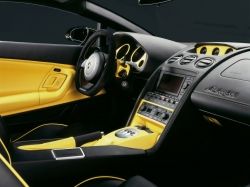
With Audi now as the new owner of Lamborghini one could see its influences coming through this model.The aluminum cylinder heads and block of this new engine were built at the Cosworth Technology factory (also owned by Audi AG), after which they are shipped to Györ in Hungary to be finished, much like other engines from the Audi range, this mighty engine was actually based on the Audi 4.2 V8 engine, sharing the 90 degree V-angle and bore centers, however the Lamborghini unit has a four valves per cylinder configuration instead of the 'Audi trademark' five valves and naturally two more cylinders.
Using a dry sump lubrication system, the engine could be mounted very low into the chassis, the actual center of gravity of the Gallardo is situated at only 46 cm from the ground, with four valves per cylinder, dual-length intake manifolds, variable control for both intake and exhaust valves, this new engine pumped out 500 Bhp at 7800 rpm, with a torque value of 510 Nm at 4500 rpm, 80 percent of which was already available at only 1500 rpm, driving sensations guaranteed ...
The interior of the Gallardo also means business, very functional and finished in the finest materials, an optional E-gear will get rid of the gearshift lever on the central console, and adds two levers behind the steering wheel to control the sequential gearbox, if you stay with the standard gearbox, you'll have a state of the art six-speed unit at your fingertips to control the VT drive train which would send about 70 percent of the power to the rear wheels in normal driving conditions, in case of traction loss at the rear, the front wheels can receive up to 50 percent of the available 500 horses located behind your back.
The Gallardo presented an entire collection of airbags, the driver's and passenger's airbag were 'two-stage' models, while the airbags mounted in the seats protected both the body as the head of those seated inside this super car, other nice touches found inside the new Lamborghini were a great quality stereo and air-conditioning (straight from an Audi A8), while a big screen DVD navigation system was available as an option, again much like the one found on the Audi A8.
Early, independent, tests have shown that the E-gear option would be advisable, since the clutch pedal for the standard gearbox required the footrest for the driver to be moved slightly towards the seat, creating a rather strange seating position that could become annoying during a long drive.
The steering wheel is adjustable for reach and height, while the leather seats are electrically adjustable in all directions too, finding a decent driving position shouldn't be too difficult inside the Gallardo.
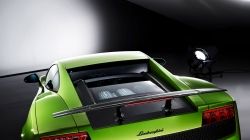
Note that the new Gallardo was the first Lamborghini to be built with massive 19-inch wheels right from the factory, perhaps these would become an option on the Murcielago, which used 'only' 18 inch wheels when introduced in 2001, a nice touch is the availability of 19 inch winter tires as an option, to improve 'everyday use' of the new Gallardo.
According to Mr Werner Mischke (chairman at Automobili Lamborghini SpA), for the first time in history a Lamborghini will be priced at exactly the same amount all over Europe, at 145.180 Euro (around US $ 165,000) the Gallardo should be a worthy competitor in the rather crowed area of the 'smaller' super cars, makes like Ferrari, Porsche and Aston Martin were also very busy in this small market, but it seems the Gallardo could be a very though car to beat when put side by side for a comparison, let's wait and see what the first production cars will feel like on the open road when tested by the, sometimes, notorious motoring press.
One of the first independent road tests revealed some interesting points, the standard ESP couldn't be completely de-activated, apparently the button on the dashboard doesn't allow the Electronic Slip Prevention to be cut off entirely, it still kicks in when driving close to the limits of the car, preventing an overly 'sporty' way of driving in favor of safety.
The cars with the optional e-Gear actually have a reprogrammed ESP system, allowing a more sporty way of driving because the threshold of activation for the ESP has been increased, note however that this threshold is set at such a level that I doubt most owners will ever reach it on the open road.
Another point the journalist noted was the fact that the engine had a very distinguished sound, not raw or anything, but more like a deep roaring sound, less loud than a Murcielago actually, also the controlling of the e-Gear could still be improved, shifting up or down sometimes isn't as smooth as it should be. Note however that any tests have been performed on pre-production models, so some changes could still be made before the first customer cars arrive in September 2003.
The optional e-Gear offers three settings, Automatic, Normal and Sport, the first one puts the focus on comfort while Normal allows the driver to switch gears manually although when reaching the maximum rpm's, the electronic controls take over and shift upwards automatically. The Sport setting on the other hand will not 'shift up' automatically and dramatically shortens the time to shift gears.
Perhaps not perfect, but the standard six speed gearbox, although it retains the magnificent 'shifting grid' on the central tunnel, uses two cables to transmit the gearlever movement ...
The Lamborghini Gallardo is actually the first 'series' production car that uses the new Koni FSD dampers. Koni's Frequency Selective Damping is a passive system that allows the suspension to be modified according to road conditions, these dampers are set 'hard' when their frequency is below 7 Hertz (7 compressions and extensions of the damper per second), while a valve is opened when this frequency is reached, resulting in a softer setting to allow more movement of the wheels to improve comfort on bad roads.
The optional 'sport suspension' doesn't lower the car this time, to avoid damage to the already very low bodywork and chassis, but instead it increases 'stiffness' by 15 percent at the front and 20 percent at the rear.
The initial setup of the suspension was to have the Gallardo understeer mildly when entering a curve, while understeer would return to neutral during the curve and remain neutral on exiting.
When driving the Gallardo during an Italian test in June 2003, the car had such a smooth drive it couldn't be compared with anything else on the super car market today, while retaining a firm control of body roll while cornering and perfect handling of pitch and roll.
The rather controversial styling of the Lamborghini Gallardo caused some very emotional reactions among current Lamborghini owners, they didn't love the Murcielago either at first, and now the Gallardo is another step from the brutal Countach and magnificent Miura.
It looks like Automobili Lamborghini SpA shed the past and headed towards the future at a very high speed, putting the current models at a level of finish and drivability never seen before on a Lamborghini, extremely reliable and somewhat easier to drive, compared to the heavy clutch on a Countach for instance, it is obvious that since the Audi AG takeover, Automobili Lamborghini SpA came a long way from the 'out of this world' brutality of the Countach and the sensual lines of the Miura, without even mentioning the classic GT's from the late Sixties and early Seventies, perhaps the company is looking for 'new' buyers instead of appealing to current Lamborghini owners ...
With a projected production of nearly 1200 Gallardo's each year (note that 3500 Ferrari Modena's are being built each year), a lot of new buyer's would be required which is probably one of the reasons why dealerships expanded globally to increase awareness and market share.
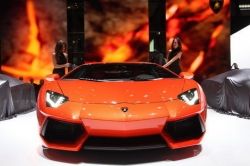
Lamborghini - Aventador
700 Bulls under the hood!
Lamborghini is really good at creating sinister super sports cars, but it is equally as talented at naming them. According to the company, "Aventador" was the name of a bull that entered into battle on October 1993 at the Saragossa Arena, earning the "Trofeo de la Peña La Madroñera" for its outstanding courage. Having the courage to go up against a new world of super sports cars will be the name of the game for the new Lamborghini flagship. Today's world is extremely high-tech and many new players have entered the arena. Lamborghini has been promoting its carbon-fiber monocoque technology and the Aventador's 2.9 second 0-62mph, but will that be enough?
The supercar is 4.78 meters long, 2.26 meters wide, and only 1.136 meters high. The proportions and body parts have been calculated to improve the car's aerodynamics as much as possible. All of the aerodynamic elements are integrated into the body shell form, from the front spoiler to the rear diffuser, while the rear spoiler is deployable and controlled electronically. The 4 degree approach angle is optimized for high speed and assists directional stability at the very top end of the spectrum. The 11 degree tilt, on the other hand, delivers considerably greater downforce at mid-range speeds, helping to optimize handling and stability.
Up front the Aventador gets an air guide further emphasised by glossy, black frames, and bi-xenon headlamps. These headlights are more than just a simple bulb behind a casing, they are an exercise in further design. The Y shaped lights spread out from the middle and a different set of LED lights within creates the turn signal. The side of the car have two sweeping strokes - the first emphasizes the front wheel arch; the second is a very sharply drawn line beginning at the front wheel arch. Lamborghini describes it as a tensed muscle running along the entire side of the car and over the rear wheel. Also, two large air intakes behind the upward-opening doors are used for a better cooling engine. Finally the rear gets a lower diffuser and rear LED lights that create the same shape as the ones out front.
In what has become one of the most distinctive features for any Lamborghini, the passenger doors will open upwards towards the sky. This feature has been used on every major Lamborghini supercar since the Countach. Few companies have been able to create a specific design element that they are able to carry through various decades with such poise. The nearest competitor may be Mercedes Benz and the 300SL Gullwing of the past and SLS AMG of today.
Customers will have the ability to choose from 13 exterior colors in pastel metallic, pearlescent, or matte. These include the newest shades of Grigio Estoque, Arancio Argos, AD Personam, Nero Nemesis, Bianco Canopus, and Marrone Apus. Automobili Lamborghini has really taken notice of the aftermarket world with their new paint options. Matte paint has become all the rage in high-end cars and can look especially striking on something as svelte as a Lamborghini. Three specific Matte tones will be available from the factory and should increase the curb appeal of these machines even further
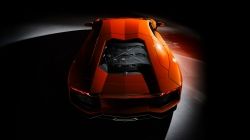
If you are one of the lucky few to have sat in a Reventon than you would know how Lamborghini was attempting to create a cockpit out of a dashboard. The revolutionary gauges that acted like the instruments of a jet plane were the first in a line of new technologies that would evolve into the Aventador. Instrumentation for the Aventador is displayed on a large LCD screen while a completely independent system and LCD screen controls stereo and navigation functions. The press release makes the center console of the car sound like your car is a robot by calling it the, "Human-Machine Interface."
The full leather single-color interior is available in either Nero Alde (black) or in Marrone Elpis, with the contrasting stitching offered in a range of colors. The two-tone leather interiors are offered in two style lines. For Bicolor Sportivo, the base color is black, with the contrast in orange, white, yellow or green, while Bicolor Elegante presents a harmonious blend of brown tones. A virtually inexhaustible array of variants is also offered by the Ad Personam individualization program.
The new Lamborghini Aventador LP700-4 went on sale in late summer 2011 at a price of $387,000. Lamborghini will be taking orders for years and will have to fill those sales requests before one just sits on a dealer's lot. In total, only 4000 units of the supercar will be produced, which is 99 units less than the Murcielago. If any more than that were produced, the Aventador would not be profitable. The carbon fiber molds that are used to construct the car's monocoque can be used as many as 500 times before they have to be replaced." The Aventador's price is equivalent to eight sets of monocoque molds.
Hope you have enjoyed reading through the history of one of the most iconic Supercar producers ever!
Lamborghini Links - Lambo post
Popular Links
- Top Gear website
Click here to go to the Official Topgear Website - Lamborghini Talk About!
Lamborghini Forums - Lamborghini In the Pit
Lamborghini Forums - DuckDuckGo.com
New Search options - Lamborghini on Google
Lamborghini on Google
